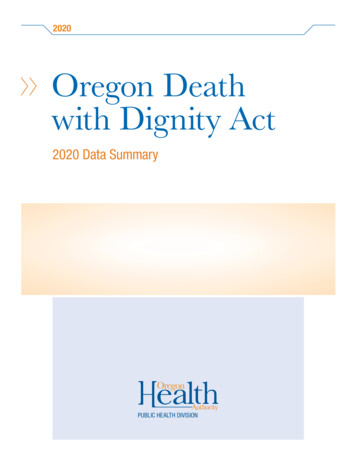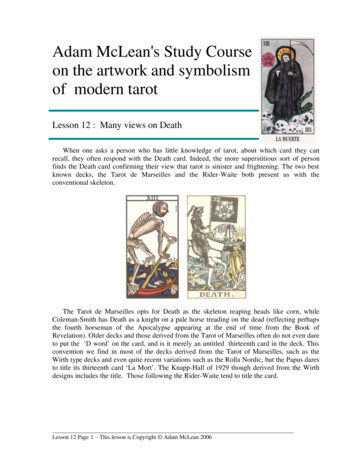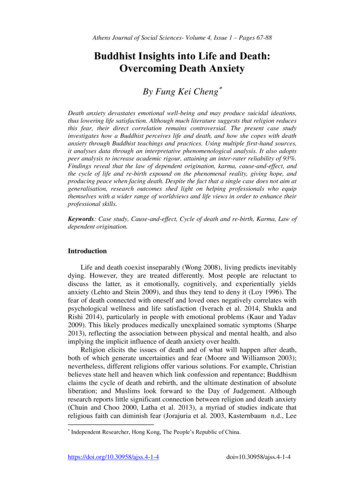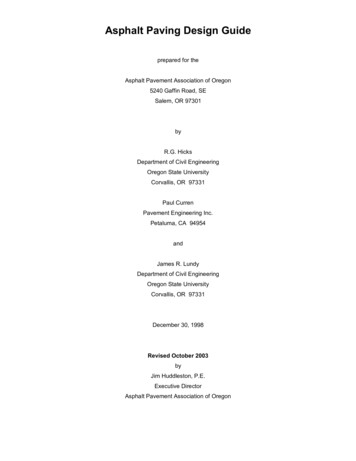
Transcription
2020Oregon Deathwith Dignity Act2020 Data SummaryPUBLIC HEALTH DIVISION
AcknowledgmentsReport written by: Public Health Division, Center for Health StatisticsDate: February 26, 2021For more information, see: www.healthoregon.org/dwdContact: DWDA.INFO@state.or.us2Acknowledgments Oregon Death with Dignity Act
Executive summaryThe Oregon Death with Dignity Act (DWDA) allows terminally ill Oregonians whomeet specific qualifications to end their lives through voluntary self-administrationof a lethal dose of medications prescribed by a physician for that purpose. TheAct requires the Oregon Health Authority (OHA) to collect information about thepatients and physicians who participate in the Act and to publish an annual statisticalreport. In 2020, 370 people were reported to have received prescriptions under theDWDA. As of January 22, 2021, 245 people had died in 2020 from ingesting theprescribed medications, including 22 who had received prescriptions in previousyears. Demographic characteristics of DWDA patients were similar to those ofprevious years: most patients were aged 65 years or older (81%) and white (97%).While cancer still accounted for most underlying illnesses (66%), patients with heartdisease (11%) outnumbered those with neurological disease (8%) for the first time in2020. OHA made no referrals to the Oregon Medical Board for failure to complywith DWDA requirements.Oregon Death with Dignity Act Executive summary3
IntroductionThe Oregon Death with Dignity Act (DWDA) allows terminally ill Oregonians whomeet specific qualifications to end their lives through voluntary self-administration of alethal dose of medications prescribed by a physician for that purpose. The Act requiresthe Oregon Health Authority (OHA) to collect information about the patients andphysicians who participate in the Act and to publish an annual statistical report.The DWDA outlines specific patient requirements to participate. A patient mustbe 1) 18 years of age or older, 2) a resident of Oregon, 3) capable of making andcommunicating health care decisions to health care practitioners, and 4) diagnosedwith a terminal illness that will lead to death within six months. The attending andconsulting physicians must determine whether a patient meets these requirementsand report that fact to OHA at the time a prescription is written. When OHAidentifies any issue of noncompliance with the statutory requirements, it reports thefact to the appropriate licensing board.Data presented in this summary, including the number of people for whom DWDAprescriptions were written (DWDA prescription recipients) and the resulting deathsfrom the ingestion of the medications (DWDA deaths), are based on requiredreporting forms and death certificates received by OHA as of January 22, 2021.More information on the reporting process, required forms and annual reportsis available at http://www.healthoregon.org/dwd.NumberFigure 1: DWDA prescription recipients and deaths*, by year, Oregon, 1998–2020400350300250200150100500Prescriptions writtenDWDA deaths'98 '99 '00 '01 '02 '03 '04 '05 '06 '07 '08 '09 '10 '11 '12 '13 '14 '15 '16 '17 '18 '19 '20Year*As of January 22, 2021See Table 2 for detailed information4Introduction Oregon Death with Dignity Act
Participation summary and trendsDuring 2020, 370 people received prescriptions for lethal doses of medicationsunder the provisions of the Oregon DWDA, a 25% increase over the 297 reportedduring 2019 (Figure 1). As of January 22, 2021, OHA had received reports of 245people who died during 2020 from ingesting the medications prescribed under theDWDA, an increase from 191 in 2019.Since the law was passed in 1997, a total of 2,895 people have received prescriptions under theDWDA and 1,905 people (66%) have died from ingesting the medications. During 2020,the estimated rate of DWDA deaths was 65.5 per 10,000 total deaths.1Figure 2 shows a summary of DWDA prescriptions written and medications ingested. Ofthe 370 patients for whom prescriptions were written during 2020, 223 (60%) died fromingesting the medication. An additional 67 (18%) did not take the medications and laterdied of other causes.At the time of reporting, ingestion status was unknown for 80 patients prescribedDWDA medications in 2020. Of these, 36 patients died but follow up information is not yetavailable. For the remaining 44 patients, both death and ingestion status are not yet known(Figure 2). In all, eight patients (3.3%) outlived their prognosis (i.e., lived more than six monthsafter their prescription).Figure 2: Summary of DWDA prescriptions written and medications ingested in 2020,as of January 22, 202122 people withprescriptions writtenin previous yearsingested medicationduring 2020370 people had prescriptionswritten during 2020223 ingestedmedication245 died fromingestingmedication in 202067 did not ingestmedication andlater died from othercauses80 ingestionstatus unknown36 died, ingestionstatus unknown44 death andingestion statusunknown1Rate per 10,000 deaths calculated using the total number of Oregon resident deaths in 2019 (37,397), the most recent year forwhich final death data are available.Oregon Death with Dignity Act Participation summary and trends5
Patient characteristicsTable 1 shows the characteristics and end-of-life care for 2020 DWDA deaths,updated data for 2019 DWDA deaths, combined data for 1998–2018 DWDAdeaths, and total DWDA deaths. Of the 245 DWDA deaths during 2020, mostpatients were aged 65 years or older (81%) and white (97%). The median age atdeath was 74 years. Forty-two percent of patients had at least a bachelor’s degree.Patients’ underlying illnesses were somewhat different from those of previousyears. Cancer remained the most common underlying illness, but nowaccounts for only two-thirds (66%) of DWDA deaths. In previous years, witha few exceptions, cancer accounted for 70%–85% of underlying illnesses. Inaddition, patients with heart disease (11%) outnumbered those with neurologicaldisease (8%) for the first time in 2020.Most patients died at home (92%) and most were enrolled in hospice care(95%). A ll patients whose health insurance status was known had someform of coverage. The percent of patients with private insurance declinedfrom 2019 (from 29% to 26%), while patients with Medicare or Medicaidinsurance increased (from 70% to 74%).As in previous years, the three most frequently reported end-of-life concerns weredecreasing ability to participate in activities that made life enjoyable (94%), loss ofautonomy (93%) and loss of dignity (72%).6Patient characteristics Oregon Death with Dignity Act
DWDA processA total of 142 physicians wrote 370 prescriptions during 2020 (1–31 prescriptionsper physician; 79% of physicians wrote one or two prescriptions). The numberof attending physicians has increased most years since 1998 and has increasedat a higher rate since 2014 (Table 2). Almost half of attending and consultingphysicians practiced in the Portland metropolitan area (48% and 49%, respectively),while just under 30% practiced in the other northwestern counties (Table 3).Three patients were referred for psychological or psychiatric evaluation. During2020, OHA made no referrals to the Oregon Medical Board for failure to complywith DWDA requirements.The DWDA now provides an exemption to the statutory waiting periods forpatients expected to live fewer than 15 days from the time of their first oralrequest for medication. In 2020, 75 patients (20%) were given exemptions.The medications prescribed to DWDA patients continues to evolve (Table 1). In2019, more than 90% of DWDA ingestions involved one of two drug combinations:DDMA, consisting of diazepam, digoxin, morphine sulfate, and amitriptyline(47% of ingestions); or DDMP, consisting of diazepam, digoxin, morphine sulfate,Figure 3: Medication used in DWDA ingestions, 019'19202020Oregon Death with Dignity Act DWDA process7
and propranolol (46% of ingestions). In 2020, most ingestions involved DDMA(87%). Only 10% of ingestions used DDMP. In late 2020, some physiciansbegan to prescribe a new drug combination – DDMA-Ph – consisting ofDDMA with the addition of phenobarbital (Figure 3).Prescribing physicians were present at time of death for 29 patients (12%). Fifty-fivepatients (22%) had other health care providers present, and volunteers were presentfor 42 deaths (24%). 1 Data on time from ingestion to death are available for 138DWDA deaths (56%) during 2020.2 Among those patients, time from ingestionuntil death ranged from six minutes to eight hours, with a median time of 50minutes (Table 1).Table 4 shows the duration from ingestion to death by medication prescribed forall known cases. Median time until death was shorter after DDMA (53 minutes)than after DDMP (85 minutes). All drug combinations have shown longer mediantimes until death than the barbiturates, secobarbital and pentobarbital, whichare no longer readily available. There is not yet sufficient data on the new drugcombination, DDMA-Ph, to estimate its effectiveness.1Due to COVID-19 precautions, providers and volunteers attended some DWDA ingestions remotely using teleconferencingsoftware (e.g., Zoom).2Includes all reports, not just those from licensed health care providers.8Patient characteristics Oregon Death with Dignity Act
Table 1. Characteristics and end-of-life care of 1,905 DWDA patients who have died fromingesting a lethal dose of medication as of January 22, 2021, Oregon, 1998–2020CharacteristicsSex2020(N 245)N (%)12019(N 191)N (%)1MaleFemale124 (50.6)121 (49.4)114 (59.7)77 (40.3)1998–2018(N 1,469)N (%)1767 (52.2)702 (47.8)Total(N 1,905)N (%)11,005 (52.8)900 485 Median years .4)(25-102)RaceWhiteAfrican AmericanAmerican IndianAsianPacific IslanderOtherTwo or more (0.1)(0.2)(1.4)(0.1)(0.3)(0.4)(1.2)5Marital statusMarried (including Registered DomesticPartner)WidowedNever marriedDivorcedUnknown113 (46.1)92 (48.2)671 (46.0)876 (46.2)58 (23.7)19 (7.8)55 (22.4)035 (18.3)24 (12.6)40 (20.9)0325 (22.3)114 (7.8)350 (24.0)9418 (22.0)157 (8.3)445 (23.5)98th grade or less9th–12th grade, no diplomaHigh school graduate/GEDSome college495645610263213603213082379403385Associate degree27 (11.0)15 (7.9)132 (9.1)174 (9.2)Bachelor's degreeMaster's degreeDoctorate or professional degreeUnknown52 (21.2)36 (14.7)16 (6.5)050 (26.3)35 (18.4)16 (8.4)1353 (24.3)159 (10.9)108 (7.4)15455 (24.1)230 (12.2)140 0.4)Oregon Death with Dignity Act Patient characteristics9
CharacteristicsResidence masDeschutesMarionOther northwest countiesSouthern OregonCentral Oregon / Columbia GorgeEastern OregonUnknown2020(N 245)2019(N 6)11998–2018(N 1,469)Total(N (4.7)(3.1)(1.6)0324 (22.2)154 (10.6)152 (10.4)91 (6.2)149 (10.2)55 (3.8)155 (10.6)217 (14.9)115 (7.9)21 (1.4)26 32 (94.7)13 (5.3)0172 (90.1)19 (9.9)01,295 (90.2)140 (9.8)341,699 (90.8)172 (9.2)3451 (25.6)148 (74.4)48 (29.1)115 (69.7)664 (49.4)664 (49.4)763 (44.7)927 (54.3)0 (0.0)462 (1.2)2616 (1.2)12518 (1.1)197End-of-life careHospiceEnrolledNot enrolledUnknownInsurancePrivateMedicare, Medicaid or OtherGovernmentalNoneUnknownUnderlying illnessCancerLip, oral cavity, and pharynxDigestive organsPancreasColonOther digestive organsRespiratory and intrathoracic organsLung and bronchusOther respiratory and intrathoracicorgansMelanoma and other skinMesothelial and soft tissueBreastFemale genital organsProstateUrinary 442Patient characteristics Oregon Death with Dignity )
CharacteristicsEye, brain, central nervous systemBrainEye and central nervous systemThyroid and other endocrineIll-defined, secondary, and unspecifiedsitesLymphoma and leukemiaOther cancersNeurological diseaseAmyotrophic lateral sclerosisOther neurological diseaseRespiratory disease [e.g., COPD]Heart/circulatory diseaseInfectious disease [e.g., HIV/AIDS]Gastrointestinal disease [e.g., liverdisease]Endocrine/metabolic disease [e.g.,diabetes]Other illnesses32020(N 245)2019(N 191)1998–2018(N 1,469)Total(N 8)(7.7)(3.1)(5.5)(5.5)(0.7)(0.9)5 (2.0)2 (1.0)11 (0.7)18 (0.9)9 (3.7)6 (3.1)17 (1.2)32 (1.7)DWDA processOutlived 6-month prognosisReferred for psychiatric evaluationPatient informed family of decision4Patient died atHome (patient, family or friend)Assisted living or foster care facility8 (3.3)3 (1.2)234 (97.1)6 (3.1)1 (0.5)181 (96.8)63 (4.3)65 (4.4)1,302 (95.5)77 (4.0)69 (3.6)1,717 (95.9)226 (92.2)15 (6.1)180 (94.2)5 (2.6)1,352 (92.4)72 (4.9)1,758 (92.6)92 (4.8)Nursing home0 (0.0)4 (2.1)14 (1.0)18 (0.9)Hospital0 (0.0)0 (0.0)4 (1.6)00 (0.0)1 (0.5)1 (0.5)04 (0.3)2 (0.1)19 (1.3)64 (0.2)3 (0.2)24 (1.3)6Hospice facilityOtherUnknownLethal medication 5.9)(10.1)(0.3)(45.1)(3.7)(3.4)(20.3)(1.2)Oregon Death with Dignity Act Patient characteristics11
CharacteristicsEnd-of-life concerns62020(N 245)2019(N 191)1998–2018(N 1,469)Total(N 1,905)Less able to engage in activities makinglife enjoyableLosing autonomyLoss of dignity7Burden on family, friends/caregiversLosing control of bodily functionsInadequate pain control, or concernabout itFinancial implications of treatment231 (94.3)172 (90.1)1,310 (89.2)1,713 ,7251,30890582252215 (6.1)14 (7.3)57 (3.9)Health care provider present(collected since 2001)(N 245)(N 191)(N 1,397)(N 73.6)(47.5)(43.1)(27.4)86 (4.5)When medication was ingestedPrescribing physicianOther provider, prescribing physiciannot presentVolunteerNo provider or volunteerUnknownAt time of deathPrescribing physicianOther provider, prescribing physiciannot presentVolunteerNo provider or volunteerUnknown29 (11.8)55 (22.4)34 (17.9)29 (15.3)201 (14.6)354 (25.7)264 (14.6)438 (24.2)42 (17.1)119 (48.6)045 (23.7)82 (43.2)120 (1.5)800 (58.2)22107 (5.9)1,001 (55.3)23Complications8(N 245)(N 191)(N 1,469)(N 51 – 12221901120 – 21381,45910120 – 21381,88718Difficulty r outcomesRegained consciousness after ingestingDWDA medicationsTiming of DWDA eventDuration (weeks) of patient-physician relationshipMedian8Range0 – 1020Patients with information available238Patients with information unknown712Patient characteristics Oregon Death with Dignity Act
Characteristics2020(N 245)Duration (days) between first request and deathMedian32Range0 – 1080Patients with information available241Patients with information unknown4Duration (minutes) between ingestionand unconsciousnessMedian5Range1 – 45Patients with information available125Patients with information unknown120Duration (minutes) between ingestionand deathMedian50Range6min-8hrsPatients with information available138Patients with information unknown1072019(N 191)1998–2018(N 1,469)Total(N 1,905)4315 – 150319104714 – 10091,4690450 – 15031,901451 – 9012012551 – 24075571451 – 1min-104hrs1,0388671 Unknowns are excluded when calculating percentages.2 Other northwest counties: Benton, Clatsop, Columbia, Lincoln, Linn, Polk, Tillamook, and Yamhill.Southern: Coos, Curry, Douglas, Josephine, Klamath, and Lake.Central/Columbia Gorge: Crook, Gilliam, Hood River, Jefferson, Sherman, Wasco, and Wheeler.Eastern: Baker, Grant, Harney, Malheur, Morrow, Umatilla, Union, and Wallowa.3 Includes deaths due to arthritis, arteritis, blood disease, complications from a fall, kidney failure,medical care complications, musculoskeletal system disorders, sclerosis, and stenosis.4 First recorded in 2001. Since then, 74 patients (4.1%) have chosen not to inform their families,and 30 patients (1.6%) have had no family to inform. Information is unknown for 14 patients.5 DDMA is a combination of diazepam, digoxin, morphine sulfate, and amitriptyline.DDMP is a combination of diazepam, digoxin, morphine sulfate, and propranolol. DDMP-1 contains10g of morphine sulfate; DDMP-2 contains 15g.DDMP-Ph is a a combination of diazepam, digoxin, morphine sulfate, amitriptyline, and phenobarbital.Phenobarbital is dispensed as a combination of phenobarbital, chloral hydrate, and morphine sulfate.6 Affirmative answers only (“Don’t know” included in negative answers). Categories are notmutually exclusive.7 First asked in 2003. Data available for 1,776 patients.8 Information about complications is reported only when a physician or another health care provideris present at the time of death.Oregon Death with Dignity Act Patient characteristics13
Table 2. Number of DWDA prescription recipients, DWDA deaths,and attending physicians, 1998–202014YearPrescriptionrecipientsDWDA 351391581781912451,905Patient characteristics Oregon Death with Dignity 6262628310610192108113142
Table 3. Primary location of practice, DWDA physicians, 2020Region2Metro counties (Clackamas, Multnomah, Washington)Northwest Oregon (excludes metro counties)Southern OregonCentral Oregon / Columbia GorgeEastern nsN (%)1N 2(49.0)(28.9)(13.7)(7.4)(1.0)21 Unknowns are excluded when calculating percentages.2 Northwest Oregon: Benton, Clatsop, Columbia, Lane, Lincoln, Linn, Marion, Polk, Tillamook and Yamhill.Southern Oregon: Coos, Curry, Douglas, Jackson, Josephine, Klamath and Lake.Central / Columbia Gorge: Crook, Deschutes, Gilliam, Hood River, Jefferson, Sherman, Wasco and Wheeler.Eastern Oregon: Baker, Grant, Harney, Malheur, Morrow, Umatilla, Union and Wallowa.Oregon Death with Dignity Act Patient characteristics15
Table 4. Duration between ingestion and death, DWDA deaths, 1Pentobarbital1DDMA 2DDMP-23DDMP-13Phenobarbital .0)(100.0)(100.0) 0)(18.2)(100.0)(43.8)(67.2)1– 6 )(59.1)(0.0)(43.8)(25.3) 6 ss6252053856773-68301379780253203439-1741372min – 83 hrs1min – 104 hrs1min – 19 hrs5min – 47 hrs10min – 21 hrs20min – 72 hrs-1min – 14 hrs1min – 104 hrs500200018Pentobarbital has been unavailable for DWDA use since 2015; secobarbital since 2019.DDMA is a combination of diazepam, digoxin, morphine sulfate, and amitriptyline.DDMP is a combination of diazepam, digoxin, morphine sulfate, and propranolol. DDMP-1 contains 10g of morphine sulfate; DDMP-2 contains 15g.Phenobarbital is dispensed as a combination of phenobarbital, chloral hydrate, and morphine sulfate.DDMA-Ph is a combination of diazepam, digoxin, morphine sulfate, amitriptyline, and phenobarbital.Patients who regained consciousness after ingestion are not considered DWDA deaths, and are not included in the other columns in this table.NOTE: Table includes all reported durations, not just those from licensed providers. Complete information not available before 2001. Unknown values areexcluded when calculating percentages.Oregon Death with Dignity Act Patient characteristics16
Oregon Death with Dignity Act Patient characteristics17
PUBLIC HEALTH tate.or.usYou can get this document in otherlanguages, large print, braille or a formatyou prefer. Contact the Publications andDesign Section at 503-378-3486 or emaildhs-oha.publicationrequest@state.or.us.We accept all relay calls or you can dial 711.OHA 8579 (02/2021)
6 Patient characteristics Oregon Death with Dignity Act Table 1 shows the characteristics and end-of-life care for 2020 DWDA deaths, updated da










